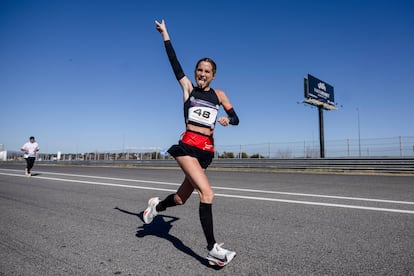Verdeliss sells better than athletics

Text in which the author advocates ideas and draws conclusions based on his or her interpretation of facts and data.

The indoor track at Gallur in Madrid is a magical space. The sun's rays filter through the wooden vaults, creating a beautiful chiaroscuro on a tartan so brown it looks like a dirt path. There, for four sessions and three days, the best of Spanish athletics has been on display to the delight of an audience of no more than 2,500 people on the best of days, who have thrilled with a Tasmanian devil called Abel Jordan, who has his roots in Cuba because of the dramas of politics and of the families who had to flee from Franco and then from Fidel, and with the best generation of sprinters in the history of this country. But also seeing Ona Bonet float over the bar or the low flight of Carmen Rosales and Jaime Guerra, who are called Aerolíneas Guerra. Or a generation of 800m runners who, so good are they, split up between the 800m and the 1,500m to win almost all the medals.
This weekend, in this magical atmosphere, Maribel Pérez broke the Spanish record for the 60m and Adrià Alfonso for the 200m. Three national U23 records also yielded to the impetus of the talented youngsters. But beyond Gallur and the community that loves old athletics and follows it on Teledeporte, in the old style, perhaps a lesser record reached the general public with greater force: the 100-kilometre record, a distance that is not Olympic and that has become a refuge for ultra-runners who did not manage to excel in the marathon and its 42.195 kilometres. A new success for Verdeliss, who became famous after running seven marathons in seven days and seven different continents.
Spain rubs its eyes at this feat, which is very well publicised and goes viral thanks to that vehicle that is social media and which accelerates news. And the media, always attentive to this accelerator of stories, immediately echo it in search of readers who click on their headlines. But almost no one tells us that Verdeliss, actually Estefanía Unzu, has a marathon record much worse than the great Spanish specialists: Majida Maayouf, Laura Luengo, Marta Galimany… Verdeliss, who has to tell another influencer , Laura Escanes, that although she has eight children and was born in Navarra, she is not from Opus Dei, skillfully dresses up her 100-kilometre record in Australia with emotional music – the song In this shirt by The Irrepressibles – and her enormous community of followers, the equivalent of the population of Bahrain, falls in love with this new success, one more. Although his true success, and a very meritorious one, is having known how to reach people better than Maribel Pérez, Adrià Pérez or the Royal Spanish Athletics Federation (RFEA).
Classic athletics sketches a half-smile and politely applauds Verdeliss' results , but behind the scenes it laments, perhaps unfairly, that she, who will never be in a European or a World Championship, and much less in an Olympic Games, has become much more famous than Maribel Pérez or Adrià Alfonso. There is only one athlete who can compete in popularity with Verdeliss, who has 1.6 million followers on Instagram, and that is Ana Peleteiro, with 500,000, and not precisely because of her Olympic medal.
But these are the new times. The RFEA published several reels on its Instagram account during the Spanish Championship and the most viewed were those featuring Águeda Marqués —who achieved great popularity (close to 100,000 followers) for her spontaneous and funny answers in the interviews she did after running in the Paris Games—, Peleteiro and Maribel Pérez (81,000 followers). The importance and weight of social media in the 21st century.
There is not only Verdeliss. Josef Ajram, also far from the elite of sport, became famous for his supposed exploits. And in the world of runners there have emerged several characters who, with greater or lesser talent for running, have had the ability to gain a remarkable number of followers (and money): Raúl Gómez, Pitufollow, Ismanon, Sarabace, Dani Castilla… Because in 2025 it may be as important to be a good athlete and reach the Olympic Games, where athletics has no rival, as to be able to gather a legion of followers who can be enchanted, like the flute player, with beautiful images, tender music and a lot of cunning. Bravo for them, but I prefer to see Mariano García and his rubber legs accelerate under the beam of light that filters through the roof of Gallur.
EL PAÍS






